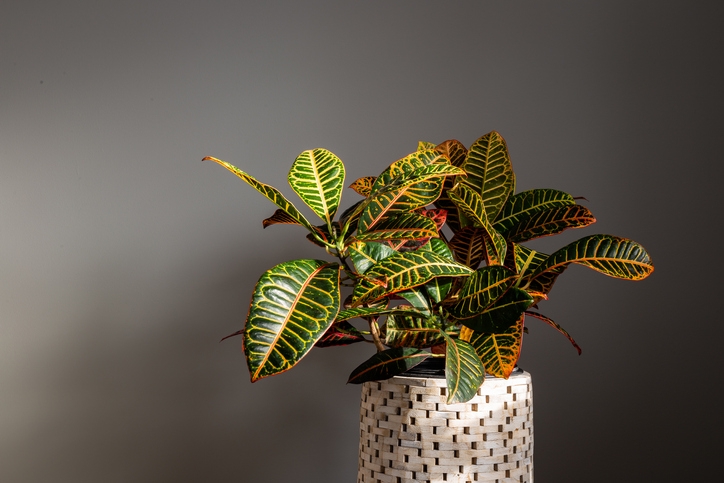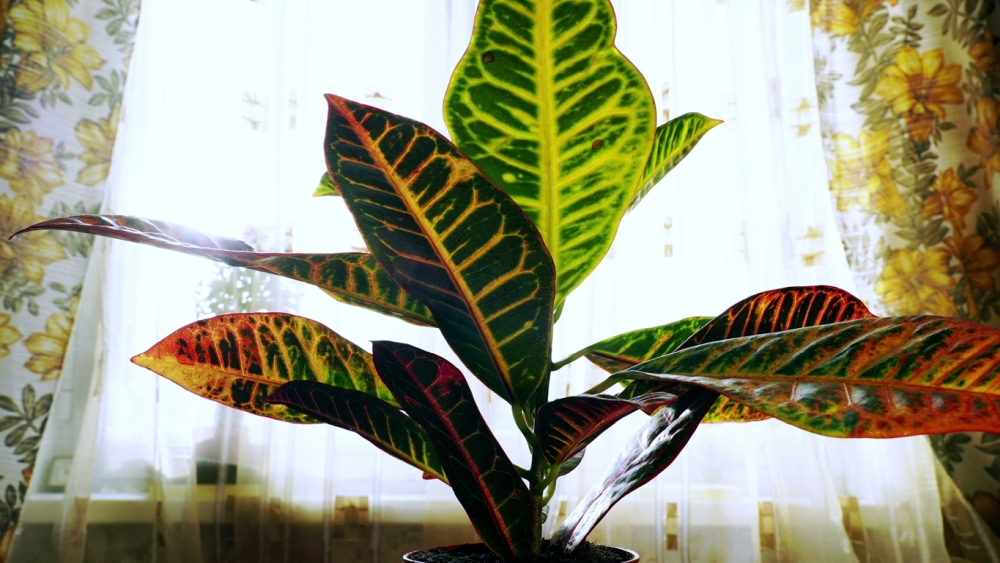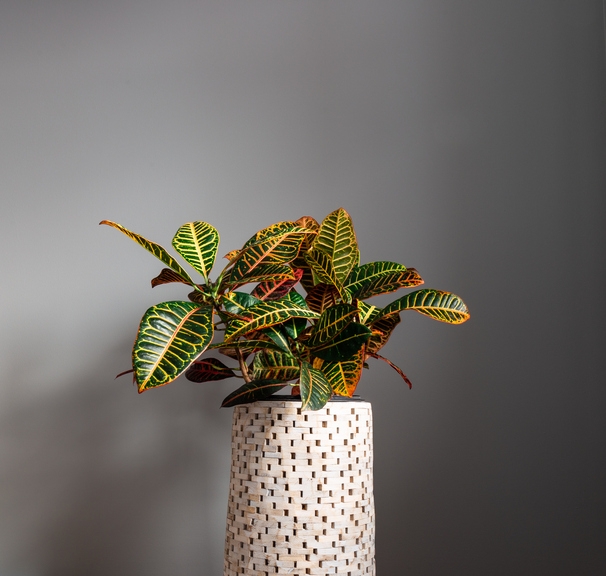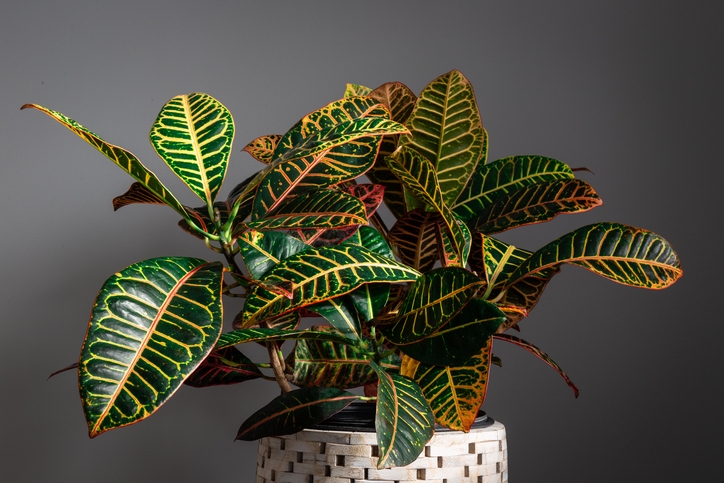With beautiful variate foliage, the croton plant can really add color to your room, and it can teach you discipline while you’re creating the perfect setup for the plant to thrive. That being said, let’s find out more about croton plants, how to care for them, and what sets them apart from all other house plants available on the market.

What is a Croton Plant?
Also known as “Codiaeum variegatum”, the croton plant is definitely visually pleasing. It has colorful foliage and leaves that are almost never identical to one another. However, croton plant indoor care can be a nuisance, as this tends to be one pretentious plant (as you’ll come to learn in the upcoming paragraphs).
We wanted to point out the fact that, while often considered difficult to care for, it becomes easier to understand the needs of a croton plant and act accordingly. Croton plants aren’t the best at making good first impressions, as it’s very common for people who have just bought one of these to notice the leaves falling off in a matter of days.
This isn’t necessarily something to worry about, as the unstable nature of the plant detects a change in its environment, causing the plant to go into shock and lose its leaves. If you stay calm and continue following the instruction below, the foliage will regrow.
How to Grow Croton Plants
#1: Light
Light is an important part of the plant growth process, and most indoor plants thrive when getting as much natural light as possible (even if that’s not the case with all plants, as some of them can grow just fine in the shade). When it comes to crotons, you want to provide it with plenty of bright and indirect light. An interesting fact about this plant is that the colors on the foliage will vary greatly depending on the amount of light exposure. What you need to remember about the croton plant is that it likes dappled sunlight.
#2: Water
The trick with watering a croton plant is to make sure that the soil is evenly moist during warmer months. During the winter, you can reduce the watering frequency to bi-weekly. You want the plant to have water at all times, but you don’t want the soil to be excessively humid.
#3: Soil
Part of proper croton plant care is making sure that you plant it in proper soil to help it thrive. Croton plants work best with well-drained potting soil. You won’t have to worry that much about fertilizer when it comes to this plant. You can either feed it liquid fertilizer or slow-release pellets during the growing season, and that should suffice.

#4: Temperature
Here is where things start to get tricky in this whole croton plant care endeavor. These plants thrive in warm and humid weather, so you’re going to have to keep them in temperatures of at least 60 degrees Fahrenheit and avoid placing them in cold drafts at all costs. The trickiest part is that, while the best humidity levels inside your home are around 50 percent, croton plants love humidity that goes all the way up to 80 percent.
Naturally, you’re going to have to find a balance between your needs and that of the plant, as humid environments can be as dangerous for human health as dry ones (especially when you consider the fact that high humidity creates an environment that favors mold growth).
If the air inside your home is too dry, you are either going to have to invest in a humidifier to help boost air humidity levels. Alternatively, you can place a humidity tray beneath the plant to help give it the moisture it needs.
#5: Potting
Croton plants are usually repotted in spring, when needed. To repot them, you can use a similar container, but it has to be at least one size larger than the current one. You can repot a croton plant by using one or two inches of peat-based potting soil into the new container, just make sure the soil is damp.
To move the plant from one container to another, simply turn it one side and slide it out of the smaller pot. Place the plant in the larger pot and place soil all around the roots. Water the soil and feel free to add more, until there is about one inch left to the rim of the pot.
#6: Propagation
If you want to grow your croton family, you can always use propagation. This is easy with the croton plant, as it is done through stem cutting. Experts recommend using rooting hormones for higher success odds. What’s interesting to note here is that the shoots that come from a parent plant can sometimes produce croton plants that are completely different from the parent plant. Avoid trying to grow croton plants from seeds, as the plant tends to be unstable.
#7: Varieties
Croton is one of the house plants that have the most varieties (literally hundreds of them). This is mostly because the plant is genetically unstable, so it’s very unlikely that you have two identical croton plants. They are typically classified based on the leaf type, with varieties that have oval, broad, twisted, and even curling leaves.
Two of the most common varieties include Gold Star (which has linear and narrow leaves with bright yellow spots, in a plant that typically grows about 20 inches in height) and Petra (a variety with green leaves that have yellow, pink, orange, or red hues, and can reach up to six feet in height).
#8: Pests and diseases
This chapter is going to be a bit longer than you might expect, because tests have revealed that croton plants can have a lot of problems when it comes to pests and diseases.
Some of the plants can end up having poor color development, with color intensity that’s uneven or poor. For your croton plant to have beautiful rich colors, light exposure is very important. Faded foliage is another aesthetic problem that you might come across if you have a croton plant. This occurs when leaves turn gray-ish and dull and is usually solved through proper ventilation and by increasing the shade level.
If you fertilize the croton plant too much, you may notice that some leaves twist too much, which is something that most people want to avoid because untwisted leaves are much more beautiful. To prevent this from happening, simply increase light intensity and reduce the fertilizer levels.
As far as bacterial problems are concerned, croton plants can end up having crown gall or Xanthomonas leaf spot. If your croton plant has crown gall, you will notice there are swollen areas on the leaf veins and stems. You may also find galls on the ends of cuttings. To control this, you’re going to have to remove and destroy the parts of the plant which are infected and sterilize the tools used to cut them. For Xanthomonas leaf spots, which are tiny water-soaked areas that tend to enlarge with time, you want to eliminate the stock plants that have it.

Insect-Related Problems
Fungus gnats
These small black flies will often be noticed frying above the soil or around the leaves of the plant. While adult gnats don’t cause direct damage to the plant, the larvae feed on parts of the plant and spin webs which are very similar to spider webs. To control them, reduce the amount of water in each pot to prevent algae growth. You can also purchase nematodes to keep these pests under control without effects on the host plant.
Mealybugs
If your croton plant is infested with mealybugs, you will notice white cotton-like masses on lower surfaces of roots and leaves. Severe mealybug infestation will cause parts of the plant to die. To control them, you want to perform soil drenches using an insecticide. Good drainage is crucial in order to avoid intoxicating your croton plant.
Mites
Due to their reduced size, a lot of people don’t even notice their plants are infested with mites until the plant suffers severe damage. In the initial stage, you might notice that leaves are cupping downward or have serrated margins. If the plant has false spider mites, the basal leaves are affected, leaves may start dropping, and vegetative shoot apexes usually end up killed. Pesticide is the best way to solve this problem.
Scales
When this problem occurs, plants start to stunt or become weak, and they eventually die. You can notice scales on a croton plant when examining the stems and leaves. They can be controlled similarly to mealybugs.
Shore flies
Often mistaken with fungus gnats, shore flies are often found buzzing around the tips of the leaves but they also fly above the soil, feeling on algae. While the adults and larvae don’t damage the plant directly, they can carry certain plant pathogens and defecate on leaves.

Are Croton Plants Toxic?
It’s very important for you to know that all parts of the croton plant are toxic, and that includes the seeds. If you have pets or children in your home, you might want to avoid having crotons, or at least make sure you place the plants out of reach.
Not only are parts of the plant poisonous when ingested, but they can also be dangerous to the touch. When you touch a damaged croton plant, it secretes a milky sap that can cause skin irritations.
Whenever you have to prune or repot your croton plants, it’s best if you use special gloves to avoid the skin from coming in contact with the irritating sap. In case of ingestion, you will notice a burning sensation on the mouth (pets tend to over-drool when tasting parts of the croton plant). If you ingest large quantities, you are likely to end up with gastrointestinal problems that range from vomiting to upset stomachs.
Conclusion
Croton plants are beautiful, as the light exposure affects their foliage and makes the leaves turn to bright and vivid colors. However, crouton plants can be rather difficult to care for, especially when you consider all the diseases and pests they could attract. If you have the patience needed for croton plant indoor care, you could end up with a gorgeous decorative plant.
